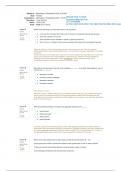Exam (elaborations)
ECS1601 ASSESSMENT 5 SEM 2 OF 2024 EXPECTED QUESTIONS AND ANSWERS
- Course
- Economics IB (ECS1601)
- Institution
- University Of South Africa (Unisa)
THIS DOCUMENT CONTAINS ECS1601 ASSESSMENT 5 SEM 2 OF 2024 EXPECTED QUESTIONS AND ANSWERS.USE IT CORRECTLY AS A GUIDE TO SCORE ABOVE 75%
[Show more]



